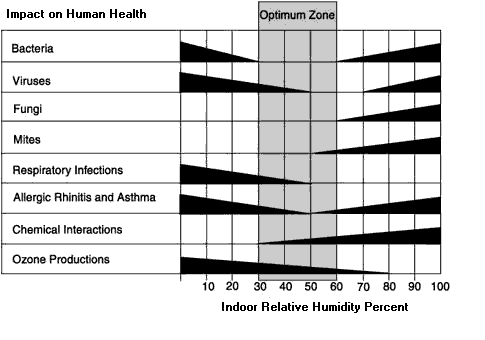
Temperature
& Humidity Thermal
comfort in the indoor
environment is defined
by ASHRAE as; "…the
condition of mind
that expresses satisfaction
with the thermal
environment; it
requires subjective
evaluation."1
The perception of
an acceptable thermal
environment is dependent
on the heat one
produces as a result
of the activities
one is engaged in,
how easily that
heat is allowed
to transfer to the
environment, and
the physiological
adjustments one's
body makes to aid
in the heat transfer
(perspiration or
chills). Because
of individual differences,
it is impossible
to specify a thermal
environment that
satisfies everyone.
Therefore, it is
generally understood
that thermal comfort
is satisfactory
when it is acceptable
to at least 80%
of building occupants.
Because of the
seasonal clothing
habits of building
occupants, the
temperature range
for comfort in
summer is higher
than in winter.
Therefore, the
operative temperature
range in a building
in which the majority
(~90%) of occupants
are performing
light, primarily
sedentary activity
at 50% relative
humidity is:
- 68ºF - 75ºF
during the winter
- 73ºF - 79ºF
during the summer
The winter and
summer comfort
zones overlap
in the 73ºF to
75ºF range. In
this temperature
zone, people in
the summer type
clothing may tend
to feel slightly
cool whereas those
in winter dress
may tend toward
feeling slightly
warm.
Regarding humidity,
the evaporation
of water from
the moist surface
of the skin directly
affects the body
temperature and
thermal sensations.
Humidity can also
indirectly affect
one's perception
of the quality
of the indoor
environment. Odors
may be stimulated
by elevated relative
humidity or the
olfactory senses
may be hindered
by low relative
humidity. Cooler,
drier indoor air
is sometimes perceived
as being "fresh"
and free from
contamination.
In a clean, non-odorous,
and well-ventilated
area the perceived
freshness of the
air may be said
to decrease with
the increase in
relative humidity.

Temperature
and humidity do
affect comfort
of building occupants
and the indoor
air quality. At
a given temperature,
decreased humidity
results in occupants
feeling cooler,
drier, and more
comfortable. "For
a sedentary person,
a 30% change in
relative humidity
has the same affect
on thermal balance
sensation as a
2ºF change in
temperature."2
The upper and
lower limits ASHRAE
recommends for
the indoor environment
are based on considerations
of dry skin, eye
irritation, respiratory
health, microbial
growth, and other
moisture related
situations. According
to ASHRAE 55-1995,
30% to 60% is
the acceptable
range of relative
humidity.
Temperature
and relative humidity
in the indoor
environment impacts
energy costs and
equipment performance
and occupant comfort
and health. Monitoring
and maintaining
these levels within
recommended guidelines
generally provides
a satisfactory
thermal environment
and does not encourage
the development
of undesirable
microorganisms.
The optimum
range of indoor
humidity is given
below and its
impact other factors
than can affect
human health.
1ANSI/ASHRAE
55-1995, Thermal
Environmental
Conditions for
Human Occupancy
2Comfort
and Humidity,
Larry G. Berglund,
Ph.D., P.E., August
1998 ASHRAE Journal